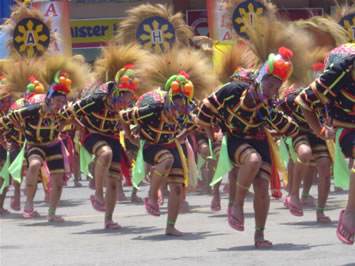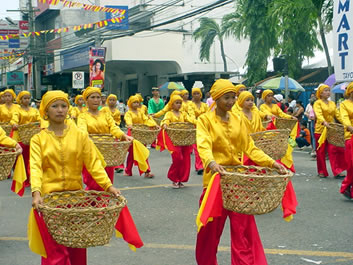Fabulous Philippines > Davao City
Davao City
Share this page:
Davao City is a large, modern and yet surprisingly relaxed city on the island of Mindinao in the southern Philippines.
Founded by the Spanish in 1849, Davao City is Mindinao's largest city and is the gateway to important tourist destinations such as Mt. Apo, the Philippine Eagle Camp, Lake Sebu and the island of Samal.

The week-long Kadayawan sa Dabaw Festival in Davao
Some of the interesting things to see in Davao City are:
-- San Pedro Cathedral
-- Lon Wa Temple
-- Taoist Temple
-- Puentespina Tropical Orchids and Plants Garden
-- Dabaw Museum
-- T'boli Weaving Center
-- Durian Monument
-- Shrine of the Holy Infant Jesus of Prague
Orchids and Fruits
Davao is often called the Garden City of the Philippines. Orchids, roses, and ornamental plants are cultivated for the landscape and the cut-flower industry.
Orchids of many varieties (both tropical and sub-tropical) grow readily in this area. The most famous orchid variety is the waling-waling (botanical name Vander sanderiana), which was originally discovered on the slopes of nearby Mt. Apo. Visitors may visit the orchid gardens in the countryside around Davao, for example, the Puentaspina Tropical Orchids and Plants Garden and the Derling Orchid Farm.
Davao has many wonderful tropical fruits, such as marang, rambutan, mangosteen, pomelo, lanzones and durian.
The durian is a bright green fruit which has a very strong (some would call it foul) smell, but which tastes like heaven. Durians are eaten fresh but also are made into durian candies, ice cream and cakes. Davao is one of the best places to obtain quality durians in the Philippines and there is even a Durian Monument (maintained by the Durian Appreciation Society) in Magsaysay Park down near the wharf.
The pomelos of Davao are renowned for being the sweetest in the Philippines.
There are many banana plantations which you can visit, such as the Lapanday Banana Plantation, about 12 km out of Davao. The most popular type of banana grown is the cavendish banana.
Festivals
Davao City holds a variety of festivals every year. These include: the Araw ng Dabaw (March); Passion plays (Easter); the Feast Day of San Pedro (June); and the Kadayawan sa Dabaw Festival (August).
The Kadayawan sa Dabaw is a thanksgiving festival. It features orchid and fruit displays and parades, indigenous sports (such as horse fights, in which stallions are pitted against each other), and art and cultural presentations.
There is a gathering of the tribes from the highlands of Mindinao, who come down and perform their traditional dances, songs and rituals in the streets to the sound of drums while dressed in their traditional costumes.
There is also a parade of colorfully decorated boats going down the Davao River.

Another photo from Davao's Kadayawan sa Dabao Festival
Dabaw Museum
The Dabaw Museum (located in the Insular Century Hotel in the suburb of Lanang) is an excellent museum which features ethnological displays, maps, dioramas and photos on the local tribal groups such as the Manobo, Mansaka, Mandaya and Bagobo. It also has weaving, costumes, wedding, burial and war artefacts, and musical instruments.
T'boli Weaving Center
At the T'boli Weaving Center, also know as Dabaw Etnika, located quite close to the Dabaw Museum, you can see traditional weavers from the T'boli tribal people at work at their looms producing hand-woven cloth. The cloth, called dagmay fabric, is made from abaca fibers and features intricate geometrical designs. The cloth is made into clothing, bags and other accessories.
Communities, Education Institutions
The population of Davao City is predominantly Christian, although there are sizeable Muslim and Chinese communities. There is a Chinatown and a Cebuano town.
The city is also a commercial, industrial and educational hub (with two universities and a number of colleges). It is also an international port with departures for Malaysia and Indonesia.
Share this page:
Author: David Paul Wagner
(David Paul Wagner on Google+)
|